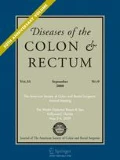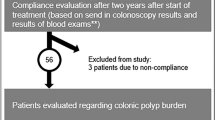Abstract
PURPOSE: A study was performed to evaluate the antiproliferative effects of low doses of the nonsteroidal drug, sulindac, on adenomas and rectal mucosa in familial adenomatous polyposis and to analyze the influence on tumor-suppressor genes and on apoptosis. METHODS: This was a prospective, controlled, nonrandomized Phase II dose-finding study for sulindac. The study group (n=28) and control group (n=10) underwent colectomy and ileorectal anastomoses, with repeated proctoscopy with endoluminal ultrasound and biopsies every three months. Dose-reduction of sulindac according to adenoma reversion was predetermined. Proliferation marker, Ki-67 (MIB1 and 5), on frozen or paraffin sections evaluated the antiproliferative effects; mutant p21 ras,pantropic p53, mutant p53, and anti -bcl-2 were performed as enzyme-linked immunosorbent assay procedures and/or immunohistochemistry on paraffin sections. RESULTS: All patients responded to sulindac after 24 weeks (at the latest). There was a significant reduction of adenomas and dose reduction to 67 mg/day after three years of therapy (Mann's test for trend,P <0.001). Results consisted of 78 percent complete reversions, 22 percent partial reversions of adenomas at latest re-examination, and no influence on upper gastrointestinal tract adenomas. No influence was detected on repeated hemograms, liver, or renal function at high or low doses. There was a permanent antiproliferative effect (Ki-67) of low-dose sulindac, significant blocking of ras mutation activation, and a significant difference of untreated and treated mucosa in mutant p53 content (Wilcoxon's or Kruskal-Wallis each,P <0.05). Reverse correlation of anti-bcl-2 and p53 immunostaining on mucosa sections was an indication of adenoma relapse. CONCLUSIONS: Low-dose antiproliferative sulindac therapy is highly effective in adenoma reversion in familial adenomatous polyposis patients. Sulindac shows influence on tumor-suppressor genes and on apoptosis markers. An immunostaining correlation indicates adenoma relapse in flat microadenomas in advance of macroscopic appearance. Low-dose sulindac treatment may develop into an additive permanent therapy for colectomized familial adenomatous polyposis patients.
Similar content being viewed by others
References
Jagelman DG: Extracolonic manifestation of familial polyposis coli. Cancer Genet Cytogenet 1987;27:319–25.
Dozois RR: Restorative proctocolectomy and ileal reservoir. Mayo Clin Proc 1986;61:283–6.
Jagelman DG: Report from the 4th biennial meeting of the Leeds Castle Polyposis Group. Int J Colorectal Dis 1991;6:224–36.
Nugent KP, Phillips RK: Rectal cancer risk in older patients with familial adenomatous polyposis and an ileorectal anastomosis: a cause of concern. Br J Surg 1992;79:1204–6.
DeCosse JJ, Bülow S, Neale K,et al.: Rectal cancer risk in patients treated for familial adenomtous polyposis. Br J Surg 1992;79:1372–5.
Nugent KP, Spigelman AD, Nicholls RJ, Talbot IC, Neale K, Phillips RK: Pouch adenomas in patients with familial adenomatous polyposis. Br J Surg 1993;80:1620.
Puthu D, Rajan N, Rao R, Rao L, Venugopal P: Carcinoma of the rectal pouch following restorative proctocolectomy: report of a case. Dis Colon Rectum 1992;35:257–60.
Hoehner JC, Metcalf AM: Development of invasive adenocarcinoma following celectomy with ileoanal anastomosis for familial polyposis coli: report of a case. Dis Colon Rectum 1994;37:824–8.
Bassuni MM, Billings PJ: Carcinoma in an ileanal pouch after restorative proctocolectomy for familial adenomatous polyposis. Br J Surg 1996;83:506.
Ziv Y, Church JM, Oakley JR, McGannon E, Fazio VW: Surgery for the teenager with familial adenomatous polyposis: ileo-rectal anastomosis or restorative proctocolectomy? Int J Colorectal Dis 1995;10:6–9.
Chameau J, D'Aubigny N, Burtin P, Person B, Boyer J: Micropolypes rectaux après colectomie totale pour polypose familiale: efficacite du sulindac. Gastroenterol Clin Biol 1990;14:153–7.
Friend WG: Sulindac suppression of colorectal polyps in Gardner's Syndrome. Am Fam Physician 1990;41:891–4.
Gonzaga RA, Lima FR, Carneiro S, Maciel J, Junior MA: Sulindac treatment for familial polyposis coli. Lancet 1985;1:751.
Iwama T, Imajo M, Mishima Y: Is sulindac effective for familial adenomatous polyposis. Int J Colorectal Dis 1991:6;235.
Labayle D, Fischer D, Vielh P,et al. Sulindac causes regression of rectal polyps in familial adenomatous polyposis. Gastroenterology 1991;101:635–9.
Waddell WR, Ganser GF, Cerise EJ, Loughry RW: Sulindac for polyposis of the colon. Am J Surg 1989;157:175–9.
Waddell WR, Loughry RW: Sulindac for polyposis of the colon. J Surg Oncol 1983;24:83–7.
Giardiello FM, Hamilton SR, Krush AJ,et al. Treatment of colonic and rectal adenomas with sulindac in familial adenomatous polyposis. N Engl J Med 1993;328:1313–6.
Rigau J, Pique JM, Rubio JM, Planas R, Tarrech JM, Bordas JM. Effects of long-term sulindac therapy on colonic polyposis. Ann Intern Med 1991;115:952–4.
Spagnesi MT, Tonelli F, Dolara P, Caderni G, Valanzano R, Anastasi A, Bianchini F. Rectal proliferation and polyp occurrence in patients with familial adenomatous polyposis after sulindac treatment. Gastroenterology 1994;106:362–6.
Nugent KP, Farmer KC, Spigelman AD, Williams CB, Phillips RK: Randomized controlled trial of the effect of sulindac on duodenal and rectal polyposis and cell proliferation in patients with adenomatous polyposis. Br J Surg 1993;80:1618–9.
Müller A, Hurlimann R, Meyenberger C, Staub P, Kobler E, Ammann R: Sulindac in familial adenomatous polyposis coli-preliminary findings of a prospective study. Schweiz Med Wochenschr 1994;124:651–4.
Giardiello FM, Offerhaus JA, Tersmette AC,et al. Sulindac induced regression of colorectal adenomas in familial adenomtaous polyposis: evaluation of predictive factors. Gut 1996;38:578–81.
Winde G, Schmid KW, Schlegel W, Fischer R, Osswald H, Bünte H: Complete reversion and prevention of rectal adenomas in colectomized patients with familial adenomatous polyposis by rectal low-dose sulindac maintenance treatment. Dis Colon Rectum 1995;38:813–30.
Piazza GA, Rahm AL, Krutzsch M,et al. Antineoplastic drugs sulindac sulfide and sulfone inhibit cell growth by inducing apoptosis. Cancer Res 1995;55:3110–6.
Sinicrope FA, Ruan SB, Cleary KR, Stephens LC, Lee JJ, Levin B: bcl-2 and p53 oncoprotein expression during colorectal tumorigenesis. Cancer Res 1995;55:237–41.
Bankfalvi A, Navabi H, Bier B, Böcker W, Jasani B, Schmid KW: Wet autoclave pretreatment for antigen retrieval in diagnostic immunochemistry. J Pathol 1994;174:223–8.
Jass JR, Sobin LH: Histological typing of intestinal tumours. Berlin: Springer-Verlag, 1989:29–32.
Lüke FJ, Schlegel W: A time-resolved fluoroimmunoassay for the determination of prostaglandin F2a. Clin Chim Acta 1990;189:257–66.
Motulsky H, ed. Intuitive biostatistics. New York: Oxford University Press, 1995.
Spagnesi MT, Tonelli F, Dolara P,et al. Rectal proliferation and polyp occurrence in patients with familial adenomatous polyposis after sulindac treatment. Gastroenterology 1994;106:362–6.
Winde G, Kautz G, Schmid KW, Osswald H, Bünte H: Magnesium oxide andα-tocopherol in treat ment of upper GI-tract adenomas in familial adenomatous polyposis. Int J Colorectal Dis 1996;11:104A.
Belchetz LA, Berk T, Bapat BV, Cohen Z, Gallinger S: Changing causes of mortality in patients with familial adenomatous polyposis. Dis Colon Rectum 1996;39:384–7.
Kashiwagi H, Spigelman AD, Talbot IC, Phillips RK: Overexpression of p53 in duodenal tumours in patients with familial adenomatous polyposis. Br J Surg 1996;83:225–8.
Fearon E, Vogelstein B: A genetic model for colorectal tumorigenesis. Cell 1990;61:759–67.
Piazza GA, Kulchak Rahm AL, Krutzsch M,et al. Antineoplastic drugs sulindac sulfide and sulfone inhibit cell growth by inducing apoptosis. Cancer Res 1995;55:3110–6.
Yamashita N, Minamoto T, Ochiai A, Onda M, Esumi H: Frequent and characteristic K-ras activation in aberrant crypt foci of colon. Cancer 1995;75:1527–33.
Minamoto T, Yamashita N, Ochiai A,et al. Mutant K-ras in apparantly normal mucosa of colorectal cancer patients. Cancer 1995;75:1520–6.
Singh J, Kelloff G, Reddy BS. Intermediate biomarkers of colon cancer: modulation of expression ofras oncogene by chemopreventive agents during azoxymethane-induced colon carcinogenesis. Carcinogenesis 1993;14:699–704.
Carney WP, Petit D, Hamer P,et al. Monoclonal antibody specific for an activatedras protein. Proc Natl Acad Sci 1986;83:7485–9.
Pullano TG, Sinn E, Carney WP. Characterizationof monoclonal antibody R256, specific for activatedras p21 with arginine at 12, and analysis of breast carcinoma of Harvey-ras transgenic mouse. Oncogene 1989;4:1003–8.
Hamer PJ, La Vecchio J, Ng SC, DeLellis R, Wolfe H, Carney WP: Activated Val-12ras p21 in cell culture fluids and mouse plasma. Oncogene 1991;6:1609–15.
La Vecchio JA, Hamer PJ, Ng SC, Trimpe KL, Carney WP. Characterization of monoclonal antibodies specific to the activatedras p21 with aspartatic acid at position 13. Oncogene 1990;5:1173–8.
Singh J, Rao CV, Kulkarni N, Simi B, Reddy BS. Molecular markers as intermediate end-points in chemoprevention of colon cancer: modulation ofras activation by sulindac and phenylhexyliso-thiocyanate during colon carcinogenesis. Int J Oncol 1994;5:1009–18.
El-Deiry WS, Tokino T, Velculescu VE,et al. WAF1, a potential mediator of p53 tumor suppression. Cell 1993;75:817–25.
Bagg A, Cossman J: BCL-2: physiology and role in neoplasia. In: Benz CC, Liu ET, eds. Oncogenes and tumor suppressor genes in human malignancies. Boston: Kluwer Academic Publishers, 1993:141–66.
Milner J, Metcalf EA: Cotranslation of activated mutant p53 with wild type drives the wild type p53 protein into the mutant conformation. Cell 1991;65:765–74.
Marks JR, Davidoff AM, Iglehart JD: p53 in human cancer. In: Garrett C, Sell S, eds. Cellular cancer markers. Totowa: Humana Press, 1995:77–110.
Howard SP, Park SJ, Hughes-Davies L, Coleman CN, Price BD: Suramin increases p53 protein levels but does not activate the p53 dependent G1 checkpoint. Clin Cancer Res 1996;2:269–76.
Shimamura A, Fisher DE: p53 in life and death. Clin Can Res 1996;2:435–40.
Sträter J, Koretz K, Günthert AR, Möller P:In situ detection of enterocytic apoptosis in normal colonic mucosa and in familial adenomatous polyposis. Gut 1995;37:819–25.
Lotem J, Sachs L: Regulation by bcl-2, c-myc, and p53 of susceptibility to induction of apoptosis by heat shock and cancer chemotherapy compounds in differentiation-competent and defective myeloid leukemic cells. Cell Growth Differ 1993;3:41–7.
Miyashita T, Krajewski S, Krajewska M,et al. Tumor suppressor p53 is a regulator of bcl-2 and bax gene expressionin vitro andin vivo. Oncogene 1994;9:1799–805.
Hockenbery DM, Zutter M, Hickey W, Nahm M, Korsmeyer SJ: Bcl-2 is an inner mitochondrial membrane protein that blocks programmed cell death. Nature 1990;348:334–6.
Oltvai ZN, Milliman CL, Korsmeyer SJ: Bcl-2 heterodimersin vivo with a conserved homolog, Bax, that accelerates programmed cell death. Cell 1993;74:606–19.
Pasricha PJ, Bedi A, O'Connor K,et al. The effects of sulindac on colorectal proliferation and apop tosis in familial adenomatous polyposis. Gastroenterology 1995;109:994–8.
Joensuu H, Pylkkanen L, Toikkanen S: Bcl-2 protein expression and long-term survival in breast cancer. Am J Pathol 1994;145:1191–8.
Sinicrope FA, Ruan SB, Cleary KR, Stephens LC, Lee J Levin B: bcl-2 and p53 oncoprotein expression during colorectal tumorigenesis. Cancer Res 1995;55:237–41.
References
Fearon ER, Vogelstein B. A genetic model for colorectal tumorigenesis. Cell 1990;61:759–67.
Kastan MB, Canman CE, Leonard CJ. P53, cell cycle control and apoptosis: implications for cancer. Cancer Metastasis Rev 1995;14:3–15.
Thorson AG, Lynch HT, Smyrk TC. Rectal cancer in FAP patients after sulindac [letter]. Lancet 1994;343:180.
Niv Y, Fraser GM. Adenocarcinoma in the rectal segment in familial polyposis coli is not prevented by sulindac therapy. Gastroenterology 1994;107:854–7.
Author information
Authors and Affiliations
Additional information
Read in part at the meeting of The American Society of Colon and Rectal Surgeons, Seattle, Washington, June 9 to 14, 1996.
About this article
Cite this article
Winde, G., Schmid, K.W., Brandt, B. et al. Clinical and genomic influence of sulindac on rectal mucosa in familial adenomatous polyposis. Dis Colon Rectum 40, 1156–1169 (1997). https://doi.org/10.1007/BF02055161
Issue Date:
DOI: https://doi.org/10.1007/BF02055161




